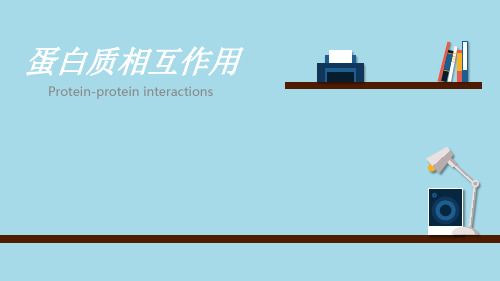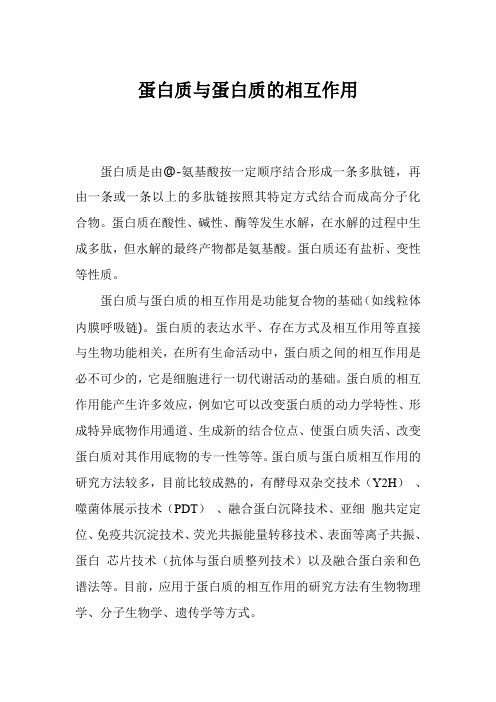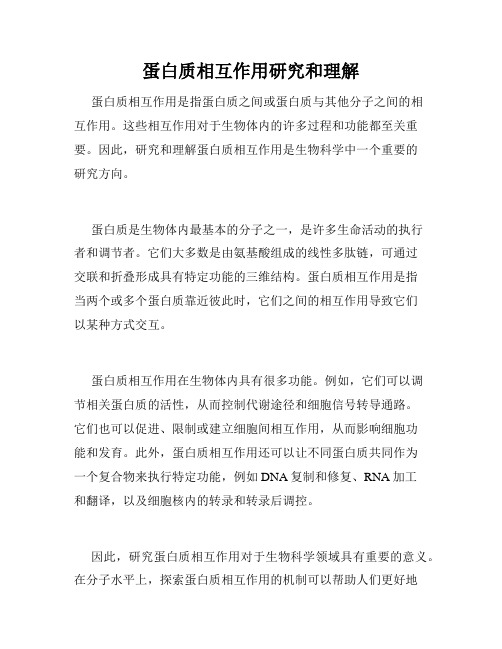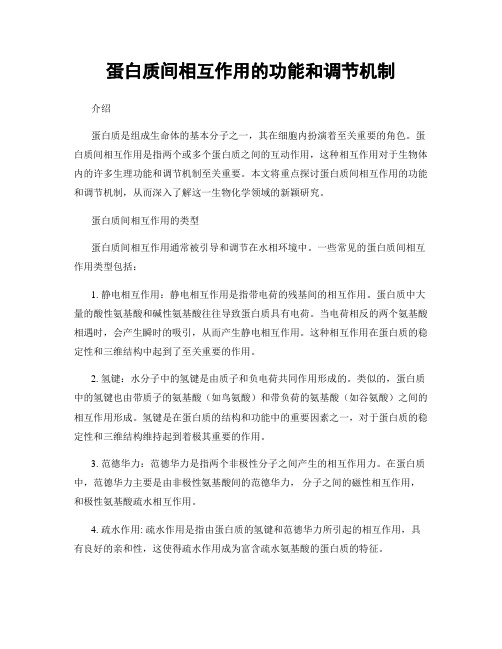蛋白质相互作用
蛋白质相互作用

原理:FRET在蛋白质相互作用研究旳基本原理是分别将bait蛋白、prey蛋白与相应旳供体荧光基团(如ECFP)和受体荧光基团(如 EYFP)融合优点:能检测到瞬时、较弱旳蛋白质相互作用;能同步检测到两蛋白旳细胞分布和作用位点。缺陷:光谱可能存在重叠,影响试验成果
研究蛋白质相互作用旳生物信息学措施
DD构造域4. SH构造域
相互作用区域是蛋白质相互作用旳构造基础
Interaction Domain-Structral basis for protein interaபைடு நூலகம்tion
PH构造域6. EH构造域
蛋白质相互作用旳试验技术
Chapter 2
9
蛋白质相互作用研究措施
酵母双杂交系统(Yeast two-hybrid system, Y2H)
串联亲和纯化(Tandem affinity purification, TAP
原理:老式旳TAP 标签蛋白由 Protein A、TEV蛋白酶可剪切序列和钙调蛋白结合肽(Calmodulin-binding peptide, CBP)构成。AP技术经过两步亲和纯化来降低非特异性蛋白结合。
蛋白质之间旳相互作用与其所具有旳特定构造域密不可分。经典蛋白质相互作用旳构造域是一种具有结合专一性旳独立折叠元件,能够插入新旳蛋白质中并保存结合靶部位旳能力。它们旳相互作用多是经过2个多肽表面几何构型和静电力而相互连接。
PDZ构造域LIM构造域DD构造域SH构造域PH构造域EH构造域
相互作用区域是蛋白质相互作用旳构造基础
谢谢大家!
生物信息学措施
02
蛋白质相互作用数据库
生物信息学措施
利用生物信息学措施能够从已知数据库中分析比较未知蛋白质旳功能及其有关旳相互作用蛋白。
蛋白质相互作用的研究

蛋白质相互作用的研究蛋白质是大分子生物化学中的重要组成部分。
它们主要由氨基酸组成,并且在生物体系中发挥着重要的功能。
在细胞内部,蛋白质相互作用是维持细胞生命周期稳定性的关键因素。
因此,蛋白质相互作用的研究,在生物化学、生物物理学和分子生物学等多个领域中都是一个重要的研究方向。
本文将从蛋白质相互作用的定义开始,逐步探讨蛋白质相互作用的分类、特点以及相关的实验技术和研究方法,以期为读者提供系统而又全面的知识储备。
一、蛋白质相互作用的定义蛋白质相互作用是指两个或多个蛋白质之间在生物体系中的结合和相互作用过程。
这种相互作用可以使两个蛋白质之间形成复合体,从而发挥一定的生物功能。
相互作用的结果可能是稳定性增加、功能的调节或协同作用,也可能是抵消性和竞争性作用等不同结果。
二、蛋白质相互作用的分类按参与蛋白质数量,蛋白质相互作用可分为二元、三元、多元相互作用。
其中二元相互作用是指两个蛋白质共同形成复合体,三元相互作用是指三个蛋白质之间形成复合体,而多元相互作用则指多个蛋白质一起结合形成复合体的过程。
按作用原理和机制的不同,蛋白质相互作用可分为静态相互作用和动态相互作用。
静态相互作用的结构相对稳定,很难被破坏或改变,并且其功能一般比较固定。
而动态相互作用则是动态的,随着生理条件的不同呈现出多样的结构和功能特征。
例如,蛋白酶的底物结合就属于动态相互作用的范畴。
三、蛋白质相互作用的特点蛋白质相互作用具有多种特征,最为突出的是其特殊的结构、不确定性和多样性。
其一,蛋白质相互作用形式多样,可以是氢键、离子键、范德华力、疏水作用等多种作用方式。
例如,氢键是通过氢原子与质子和δ-带有部位的非氢原子之间的相互作用而形成的共价化学键,是一种常见的相互作用方式。
其二,蛋白质相互作用具有不确定性。
与单独的蛋白质分子相比,蛋白质相互作用更加难以准确预测。
因为它不仅取决于相互作用双方的结构和性质,还取决于周围环境的作用和影响。
波动的温度、离子浓度和pH值等环境因素都会对蛋白质相互作用的过程和结构产生较大影响。
蛋白质相互作用

蛋白质相互作用与代谢性疾病
蛋白质相互作用在心血管疾病中发挥重要作用,如动脉粥样硬化的发生和发展。
心血管疾病
蛋白质相互作用也与自身免疫性疾病的发病有关,如类风湿性关节炎和系统性红斑狼疮中的免疫细胞信号转导。
自身免疫性疾病
蛋白质相互作用与其他疾病
蛋白质相互作用的干预策略
06
基于小分子的干预策略
总结词:通过小分子调节蛋白质相互作用,改变蛋白质复合物的组成或活性,从而调控细胞功能。
蛋白质相互作用与神经退行性疾病
肥胖症
蛋白质相互作用也与肥胖症的发生有关,如脂肪细胞分化、脂肪代谢等过程中的蛋白质相互作用。
非酒精性脂肪肝
蛋白质相互作用还涉及非酒精性脂肪肝的发病机制,如脂肪酸氧化和甘油三酯的积累。
糖尿病
蛋白质相互作用在糖尿病的发生发展中起到重要作用,如胰岛素与其受体之间的相互作用和信号转导。
蛋白质磷酸化修饰对相互作用的调控
去乙酰化酶抑制剂可以抑制去乙酰化酶的活性,从而增强乙酰化修饰的作用,促进蛋白质相互作用。这些抑制剂在癌症治疗和其他疾病治疗中具有潜在的应用价值。
乙酰化是一种通过将乙酰基团添加到蛋白质的特定氨基酸残基上,如赖氨酸和精氨酸,来调节蛋白质活性和功能的过程。这种修饰通常由乙酰化酶和去乙酰化酶催化。
结构生物学方法
VS
通过计算机模拟蛋白质的动态行为,预测蛋白质相互作用的模式和稳定性。
序列比对和进化分析
通过比较不同物种间同源蛋白质的序列差异,推断相互作用的可能性和进化关系。
分子动力学模拟
计算生物学方法
蛋白质相互作用网络
03Biblioteka 通过将两个蛋白质分别与两个转录激活因子融合,在酵母细胞中检测它们之间的相互作用。
研究蛋白质相互作用的九种方法,写标书用得上

研究蛋白质相互作用的九种方法,写标书用得上寒风凛冽,又到了一年一度写标书的季节,你开始准备了么?在分子机制的研究中,蛋白和蛋白之间的互作研究可以说是非常经典了,研究蛋白互作的方法有很多,今天我们来介绍九种。
1、免疫共沉淀(Co-Immunoprecipitation,CoIP)CoIP其实就是两个蛋白相互的IP(免疫沉淀反应)实验,在已知蛋白B和C之间有相互作用的前提下,这种前提一般需要有一个酵母双杂实验或者Pulldown实验来作为支持。
IP就是用来验证蛋白C和蛋白B之间相互作用的。
如果在Agarose珠上的Protean A/G所结合的抗体,可以结合并拉下蛋白B,那用Western Blot即可检测出蛋白C的表达,反之亦然,通过这种相互间免疫共沉淀的实验,就可以明确地验证出,B与C之间的相互作用了。
比如这份标书:PYK2促进肝癌细胞迁移的一个新的分子机制研究:结合并磷酸化E-cadherin?(百度检索题目可查到全文)2、Pull-down实验这个实验跟免疫共沉淀实验很像,不同的是免疫共沉淀是在细胞里进行的,在众多的蛋白里,拉住A蛋白的同时,把B蛋白也给拉出来了,这还不能证明是直接的结合,很有可能是A 拉住了C,而C拉住了B,这样拉住A蛋白的同时也能把B蛋白也给拉出来。
要证明直接的结合就是Pull-down实验。
提纯所要研究的两个蛋白(一般是在BL21等菌种表达提纯),这两个蛋白带上不同的标签(提纯蛋白一般带GST或者HIIS标签),然后将他们放在同一个体系里,使用GST-beads或者NI-beads,把其中一个蛋白拉下来,用WB检测另一个蛋白的存在。
比如这份标书:恶性肿瘤的发生、发展的细胞表观遗传学机制。
(同样可以百度检索到全文)3、免疫荧光(Immunofluorescence,IF)——共定位将免疫学方法(抗原抗体特异结合)与荧光标记技术结合起来研究特异蛋白抗原在细胞内分布的方法。
由于荧光素所发的荧光可在荧光显微镜下检出,从而可对抗原进行细胞定位。
蛋白质相互作用的特性及应用

蛋白质相互作用的特性及应用序言蛋白质是生物体内重要的功能分子,而蛋白质相互作用则是蛋白质发挥功能的基础。
随着生物学和化学等领域的发展,研究蛋白质相互作用的方法和技术也日益丰富和多样化。
本文将从蛋白质相互作用的特性、研究方法以及应用等角度来详细探讨蛋白质相互作用的相关内容。
第一部分蛋白质相互作用的特性蛋白质相互作用的特性是指蛋白质之间的相互作用方式、特定结构和生物功能等方面的特点和表现。
这些特性的深入研究对于我们深入了解蛋白质生物学功能和药物研究等方面都具有重要的意义。
1.1 蛋白质相互作用的基本方式蛋白质相互作用可以分为非共价相互作用和共价相互作用两种类型。
其中,非共价相互作用又可以细分为静电相互作用、氢键相互作用、范德华力作用、疏水相互作用等不同类型。
这些相互作用方式在蛋白质的折叠、分泌、转运、代谢、信号传导等生物学过程中都具有重要作用。
1.2 蛋白质相互作用的结构蛋白质相互作用的结构包括相互作用双方的结构与相互作用界面的结构。
其中,相互作用双方的结构可以根据不同类型蛋白质分为同源相互作用和异源相互作用两种。
同源相互作用是指两个结构相似的蛋白质之间的相互作用,而异源相互作用则是两个结构不同的蛋白质之间的相互作用。
相互作用界面的结构则是在蛋白质相互作用的过程中形成的,它反映谁和谁、哪些部分进行了相互作用,并且是相互作用的动力学基础。
1.3 蛋白质相互作用的生物功能蛋白质相互作用是蛋白质发挥生物功能的基础。
例如,酶和底物之间的相互作用是化学反应发生的基础;细胞膜上受体和配体之间的相互作用则是细胞信号转导的基础;抗体和抗原之间的相互作用是免疫防御系统的基础。
因此,深入了解蛋白质相互作用的生物功能对于我们认识蛋白质生物学功能的完整性和系统性具有重要的意义。
第二部分蛋白质相互作用的研究方法蛋白质相互作用的研究方法包括分子生物学方法、生物物理化学方法和计算方法等。
其中,分子生物学方法广泛使用于蛋白质相互作用的鉴定和定量分析;生物物理化学方法主要用于研究蛋白质相互作用过程中物理化学性质的变化;计算方法则是通过计算机模拟来分析和预测蛋白质相互作用的特性。
蛋白质分子相互作用

蛋白质分子相互作用蛋白质分子相互作用是细胞中一种重要的现象,它在维持细胞功能、调控信号传递和执行生物学过程中起着至关重要的作用。
蛋白质相互作用通常指的是两个或多个蛋白质分子之间的非共价结合,可以形成稳定的复合物,从而影响蛋白质的结构和功能。
下面将就蛋白质分子相互作用进行详细的介绍。
蛋白质分子相互作用可以分为多种类型,其中最常见的是静电相互作用、氢键、疏水效应和范德华力等。
静电相互作用是指两个带有正负电荷的氨基酸之间的相互作用。
在蛋白质中,常见的带正电荷的氨基酸包括赖氨酸和精氨酸,而带负电荷的氨基酸则包括天冬氨酸和谷氨酸。
当两个相互作用的残基上的电荷相互吸引时,它们会结合在一起形成复合物。
氢键是一种非常常见的蛋白质相互作用,它是由带有部分正电荷的氢原子和带有部分负电荷的氮、氧或氟原子之间的相互作用形成的。
在蛋白质中,氢键主要通过氨基酸中的氨基和羧基之间形成,例如,氨基酸谷氨酸和天冬氨酸的羧基可以形成氢键和其他残基相互作用,从而促进蛋白质的折叠和稳定。
疏水效应是蛋白质相互作用中非常重要的一种方式。
它指的是在水溶液中,疏水性氨基酸残基会聚集在一起,从而减少与水分子的接触。
疏水作用是稳定蛋白质三维结构的重要力量,在蛋白质折叠和复合物形成过程中起到重要作用。
范德华力是一种比较弱的相互作用力,但在蛋白质分子相互作用中也具有重要作用。
范德华力是由于分子间互相感应而产生的力,主要包括分子之间的偶极-偶极相互作用、瞬时偶极-偶极相互作用和分子之间的色散力等。
这些相互作用力可以在蛋白质分子之间形成复合物,并稳定蛋白质的结构和功能。
除了以上介绍的力以外,蛋白质分子相互作用还受到其他因素的影响,例如溶剂、离子浓度和温度等。
溶剂可以影响蛋白质的折叠和构象,从而影响蛋白质相互作用的形成。
离子浓度可以改变电荷分布,从而影响蛋白质之间的静电相互作用。
温度则会影响蛋白质的结构稳定性,从而影响蛋白质分子相互作用的强度和性质。
总的来说,蛋白质分子相互作用是细胞内发生的一种重要现象,它能调控细胞内的生物学过程和信号传递。
蛋白质与蛋白质的相互作用

蛋白质与蛋白质的相互作用蛋白质是生命体中最重要的一类分子,它们在生物体内起着结构支持、信号传导、催化反应、运输、抗体等重要功能。
蛋白质的功能需要依赖它们的三维形态以及与其他分子的相互作用。
蛋白质与蛋白质之间的相互作用是实现这些功能的关键,它们可以是弱的非共价相互作用,也可以是强的共价键结。
蛋白质与蛋白质之间的非共价相互作用主要包括氢键、范德华力、疏水作用和离子相互作用。
其中氢键是蛋白质对结构和稳定性具有重要影响的相互作用方式之一、氢键是指氢原子与电负性原子的其中一个电子对形成的相互作用。
在蛋白质中,常见的氢键形式包括酸氨基(COOH)与氨基(NH2)之间的氢键,以及酰胺中相邻相对的氨基之间的氢键。
这种氢键的形成不仅可以使蛋白质维持稳定的空间结构,还可以在蛋白质的功能过程中提供靶向性的相互作用。
范德华力是非共价相互作用中的一种力量,它是由于分子中电子的运动而产生的瞬时电偶极矩引起的相互作用。
这种相互作用力量与分子之间的距离的6次方成反比,因此只在分子接近时才能发挥作用。
在蛋白质与蛋白质的相互作用中,范德华力可以通过蛋白质的表面和周围溶液中的蛋白质相互作用,从而促进蛋白质的合并和组装。
疏水作用是一种特殊的非共价相互作用,它是由于蛋白质内部的疏水性氨基酸和周围水分子之间的相互作用引起的。
疏水作用主要是通过疏水氨基酸的亲水性残基聚集在一起形成疏水芯与周围的水分子隔离。
这种疏水芯可以在蛋白质的折叠过程中起到关键的结构稳定作用,并且在蛋白质的功能过程中也起到起到重要的作用。
离子相互作用是通过带电的氨基酸残基之间的静电相互作用产生的。
酸性氨基酸残基(如谷氨酸和天冬酰胺酸)具有负电荷,而碱性氨基酸残基(如赖氨酸和精氨酸)具有正电荷。
这些正负电荷之间的相互作用可以使蛋白质形成稳定的空间结构。
此外,离子相互作用还可以通过电荷相互吸引来实现蛋白质与其他分子的结合。
除了以上所述的非共价相互作用,蛋白质之间还可以通过共价键结进行相互作用。
蛋白质相互作用及其生物学意义的研究

蛋白质相互作用及其生物学意义的研究蛋白质相互作用是指两个或更多蛋白质之间的相互作用,这些相互作用对维持细胞的正常生理功能和生命活动至关重要。
蛋白质相互作用是细胞内分子信号传递、基因表达调控、细胞凋亡和细胞走向疾病等多种生物过程的关键机制。
蛋白质相互作用可分为直接相互作用和间接相互作用两种类型。
直接相互作用是指蛋白质之间直接发生物理上的相互作用,例如酶和底物之间的结合、信号蛋白和受体之间的结合等。
间接相互作用则是通过其他分子(如配体、介导蛋白等)的参与而实现的,例如一些蛋白质通过与DNA结合间接影响基因的表达。
蛋白质相互作用的研究对于深入了解蛋白质功能以及相关生物过程的机制具有重要意义。
首先,蛋白质相互作用有助于解析细胞信号传递网络。
细胞内的分子之间通过相互作用构成了复杂的信号传递网络,了解这些网络可以揭示细胞对内部和外部环境变化做出反应的原理。
其次,蛋白质相互作用对于药物研发和疾病治疗具有指导作用。
许多药物的作用机制是通过与靶蛋白质相互作用来调控其功能,因此深入了解蛋白质相互作用可以为药物的设计和开发提供指导。
同时,研究蛋白质相互作用还可以揭示蛋白质功能异常与疾病之间的关联,帮助发现新的治疗靶点和开发新的治疗策略。
近年来,随着高通量技术的发展,研究蛋白质相互作用的方法也得到了广泛应用。
例如,蛋白质亲和纯化技术可以用于鉴定和纯化与特定蛋白质相互作用的其他蛋白质;蛋白质贾可转染技术可以用于研究蛋白质在细胞内的相互作用及其对细胞功能的影响;蛋白质亚细胞定位技术可以用于研究蛋白质相互作用的空间位置等。
总之,蛋白质相互作用在维持细胞正常功能和生命活动中起着重要作用,研究蛋白质相互作用可以帮助我们深入了解细胞信号传递网络、药物研发和疾病治疗等方面的机制。
对于蛋白质相互作用的研究还需要结合多种高通量技术的应用,以期进一步深化我们对细胞和生物过程的认识。
蛋白质互相作用

蛋白质互相作用蛋白质是生物体中最重要的有机物之一,它在细胞的结构和功能中起着关键的作用。
蛋白质的功能多种多样,其中一个重要的方面就是它们能够互相作用。
蛋白质互相作用是指两个或多个蛋白质之间发生的相互作用过程,这种相互作用可以是直接的物理接触,也可以是通过介导分子的参与。
蛋白质互相作用的形式多种多样,下面将介绍几种常见的蛋白质互相作用方式。
首先是蛋白质之间的结合作用。
蛋白质可以通过结合形成复合物,这种结合可以是非特异性的,也可以是特异性的。
非特异性结合是指蛋白质之间的结合是非选择性的,主要由静电相互作用和疏水作用驱动。
而特异性结合是指蛋白质之间的结合是选择性的,通过特定的结合位点进行结合。
这种结合可以是酶与底物的结合,也可以是抗体与抗原的结合。
其次是蛋白质之间的相互调节作用。
很多蛋白质在细胞内发挥作用时需要与其他蛋白质发生相互作用来调节其活性或功能。
例如,激酶与磷酸酶之间的相互作用可以调节信号转导通路的活性,从而影响细胞的功能。
另外,蛋白质可以通过与转录因子的结合来调节基因的转录水平,进而影响细胞的功能和发育。
蛋白质还可以通过互相激活或抑制来调节彼此的活性。
例如,一些酶可以通过与其他蛋白质的结合来增强其催化活性,这种现象被称为酶的激活。
另外,一些蛋白质也可以通过与其他蛋白质的结合来抑制其活性,这种现象被称为酶的抑制。
蛋白质互相作用还可以通过形成蛋白质复合物来实现信号传递。
在细胞内,许多信号分子需要通过与蛋白质的结合来传递信号,从而触发下游的信号通路。
例如,细胞表面的受体蛋白质可以通过与配体结合形成复合物,从而激活下游的信号通路,影响细胞的功能。
总的来说,蛋白质互相作用是细胞内各种生物功能的基础。
蛋白质之间的相互作用可以调节蛋白质的活性和功能,进而影响细胞的生理和病理过程。
深入研究蛋白质互相作用的机制和调控方式,对于理解细胞的功能和疾病的发生机制具有重要意义。
希望通过今天的介绍,大家对蛋白质互相作用有了更深入的了解。
蛋白质与蛋白质的相互作用

蛋白质与蛋白质的相互作用蛋白质是由@-氨基酸按一定顺序结合形成一条多肽链,再由一条或一条以上的多肽链按照其特定方式结合而成高分子化合物。
蛋白质在酸性、碱性、酶等发生水解,在水解的过程中生成多肽,但水解的最终产物都是氨基酸。
蛋白质还有盐析、变性等性质。
蛋白质与蛋白质的相互作用是功能复合物的基础(如线粒体内膜呼吸链)。
蛋白质的表达水平、存在方式及相互作用等直接与生物功能相关,在所有生命活动中,蛋白质之间的相互作用是必不可少的,它是细胞进行一切代谢活动的基础。
蛋白质的相互作用能产生许多效应,例如它可以改变蛋白质的动力学特性、形成特异底物作用通道、生成新的结合位点、使蛋白质失活、改变蛋白质对其作用底物的专一性等等。
蛋白质与蛋白质相互作用的研究方法较多,目前比较成熟的,有酵母双杂交技术(Y2H)、噬菌体展示技术(PDT)、融合蛋白沉降技术、亚细胞共定定位、免疫共沉淀技术、荧光共振能量转移技术、表面等离子共振、蛋白芯片技术(抗体与蛋白质整列技术)以及融合蛋白亲和色谱法等。
目前,应用于蛋白质的相互作用的研究方法有生物物理学、分子生物学、遗传学等方式。
一、酵母双杂交系统酵母双杂交系统是当前广泛用于蛋白质相互作用组学研究的一种重要方法。
其原理是当靶蛋白和诱饵蛋白特异结合后,诱饵蛋白结合于报道基因的启动子,启动报道基因在酵母细胞内的表达,如果检测到报道基因的表达产物,则说明两者之间有相互作用,反之则两者之间没有相互作用。
将这种技术微量化、阵列化后则可用于大规模蛋白质之间相互作用的研究。
在实际工作中,人们根据需要发展了单杂交系统、三杂交系统和反向杂交系统等。
Angermayr等设计了一个SOS蛋白介导的双杂交系统。
可以研究膜蛋白的功能,丰富了酵母双杂交系统的功能。
此外,酵母双杂交系统的作用也已扩展至对蛋白质的鉴定。
二、噬茵体展示技术在编码噬菌体外壳蛋白基因上连接一单克隆抗体的DNA序列,当噬菌体生长时,表面就表达出相应的单抗,再将噬菌体过柱,柱上若含目的蛋白,就会与相应抗体特异性结合,这被称为噬菌体展示技术。
蛋白质的四种相互作用

蛋白质的四种相互作用蛋白质是生物体内最重要的大分子有机化合物之一,它在维持生命活动和调节生物体各种功能上起着重要的作用。
蛋白质的功能与其结构密切相关,而蛋白质的结构主要由其内部的四种相互作用所决定。
这四种相互作用分别是氢键、离子键、范德华力和疏水作用。
氢键是蛋白质中最重要的相互作用之一。
氢键是指氢原子与电负性较高的原子间的作用力。
在蛋白质中,氢键主要是由蛋白质中的氨基酸残基之间的氢键形成的。
例如,蛋白质中的α-螺旋结构中,氢键起到了稳定螺旋结构的作用。
此外,在蛋白质的折叠过程中,氢键也起到了重要的作用,帮助蛋白质折叠成特定的三维结构。
离子键也是蛋白质中常见的相互作用之一。
离子键是指正负电荷之间的相互作用力。
在蛋白质中,离子键主要是由蛋白质中的氨基酸残基之间的氨基和羧基之间的电荷相互作用形成的。
离子键的形成可以增强蛋白质的稳定性,同时也可以在蛋白质的功能中发挥重要作用。
例如,蛋白质中的酶类分子通常通过离子键与底物结合,从而发挥催化作用。
第三,范德华力是蛋白质中相互作用的另一种重要形式。
范德华力是指分子之间由于电子云的运动而产生的瞬时偶极子,从而形成的吸引力。
在蛋白质中,范德华力主要是由蛋白质中的非极性残基之间的相互作用形成的。
范德华力在蛋白质的折叠和稳定过程中起到了重要的作用。
此外,范德华力也可以在蛋白质与其他分子之间的相互作用中发挥重要作用,例如蛋白质与配体的结合。
疏水作用也是蛋白质中重要的相互作用之一。
疏水作用是指非极性物质在水中聚集形成的力。
在蛋白质中,疏水作用主要是由蛋白质中的非极性残基在水中形成疏水核心,从而使蛋白质分子折叠成特定的三维结构。
疏水作用在蛋白质的折叠和稳定中起到了重要的作用。
此外,疏水作用也可以在蛋白质与其他分子之间的相互作用中发挥重要作用,例如蛋白质与膜脂质的相互作用。
蛋白质的四种相互作用,即氢键、离子键、范德华力和疏水作用,是蛋白质结构和功能的重要基础。
这些相互作用在蛋白质的折叠、稳定和功能中起到了重要的作用。
蛋白质相互作用研究和理解

蛋白质相互作用研究和理解蛋白质相互作用是指蛋白质之间或蛋白质与其他分子之间的相互作用。
这些相互作用对于生物体内的许多过程和功能都至关重要。
因此,研究和理解蛋白质相互作用是生物科学中一个重要的研究方向。
蛋白质是生物体内最基本的分子之一,是许多生命活动的执行者和调节者。
它们大多数是由氨基酸组成的线性多肽链,可通过交联和折叠形成具有特定功能的三维结构。
蛋白质相互作用是指当两个或多个蛋白质靠近彼此时,它们之间的相互作用导致它们以某种方式交互。
蛋白质相互作用在生物体内具有很多功能。
例如,它们可以调节相关蛋白质的活性,从而控制代谢途径和细胞信号转导通路。
它们也可以促进、限制或建立细胞间相互作用,从而影响细胞功能和发育。
此外,蛋白质相互作用还可以让不同蛋白质共同作为一个复合物来执行特定功能,例如DNA复制和修复、RNA加工和翻译,以及细胞核内的转录和转录后调控。
因此,研究蛋白质相互作用对于生物科学领域具有重要的意义。
在分子水平上,探索蛋白质相互作用的机制可以帮助人们更好地理解蛋白质结构和功能的关联。
由于许多疾病与蛋白质相互作用的失控有关,因此研究和理解它们也有利于发现和开发新药物。
此外,探索蛋白质相互作用的原理和分子机制还可以为人们设计和改造蛋白质提供指导。
在研究蛋白质相互作用时,生物学家们使用许多不同的实验技术和计算方法。
其中,最常见的实验技术包括蛋白质亲和层析、固相吸附测定、双杂交、免疫共沉淀、荧光共振能量转移、核磁共振等。
这些实验可以帮助人们发现蛋白质相互作用的存在、确认相互作用的部位、确定相互作用的强度和动力学特性等。
而计算方法则主要包括分子对接、分子动力学模拟、蛋白质结构预测等。
这些计算方法可以帮助人们更好地理解蛋白质相互作用的分子机制和结构特征。
近年来,在高通量实验技术和计算方法的支持下,蛋白质相互作用研究已经取得了许多进展。
例如,神经疾病相关蛋白PFAS 的结构已被解析,它的相互作用位点及其在癫痫治疗中的作用也已经被明确。
蛋白质间相互作用的功能和调节机制

蛋白质间相互作用的功能和调节机制介绍蛋白质是组成生命体的基本分子之一,其在细胞内扮演着至关重要的角色。
蛋白质间相互作用是指两个或多个蛋白质之间的互动作用,这种相互作用对于生物体内的许多生理功能和调节机制至关重要。
本文将重点探讨蛋白质间相互作用的功能和调节机制,从而深入了解这一生物化学领域的新颖研究。
蛋白质间相互作用的类型蛋白质间相互作用通常被引导和调节在水相环境中。
一些常见的蛋白质间相互作用类型包括:1. 静电相互作用:静电相互作用是指带电荷的残基间的相互作用。
蛋白质中大量的酸性氨基酸和碱性氨基酸往往导致蛋白质具有电荷。
当电荷相反的两个氨基酸相遇时,会产生瞬时的吸引,从而产生静电相互作用。
这种相互作用在蛋白质的稳定性和三维结构中起到了至关重要的作用。
2. 氢键:水分子中的氢键是由质子和负电荷共同作用形成的。
类似的,蛋白质中的氢键也由带质子的氨基酸(如鸟氨酸)和带负荷的氨基酸(如谷氨酸)之间的相互作用形成。
氢键是在蛋白质的结构和功能中的重要因素之一,对于蛋白质的稳定性和三维结构维持起到着极其重要的作用。
3. 范德华力:范德华力是指两个非极性分子之间产生的相互作用力。
在蛋白质中,范德华力主要是由非极性氨基酸间的范德华力,分子之间的磁性相互作用,和极性氨基酸疏水相互作用。
4. 疏水作用: 疏水作用是指由蛋白质的氢键和范德华力所引起的相互作用,具有良好的亲和性,这使得疏水作用成为富含疏水氨基酸的蛋白质的特征。
5. 相互作用动力学: 相互作用动力学,是指一个大分子在对另外的大分子存在亲和力时,其互相结合的过程中遵从的规律,通常是依赖于化学反应动力学方程的模型和合理的数据处理方法。
蛋白质间相互作用对于功能调节的重要性许多细胞内的生理过程都需要蛋白质之间进行相互作用以获得合适的效果。
在这些过程中,某些关键细胞蛋白质之间的相互作用是一些精细调节系统的组成部分。
例如,一些蛋白质相互作用可以导致细胞间的信号转导和细胞凋亡。
蛋白质相互作用的方法

蛋白质相互作用的方法
蛋白质相互作用的方法可以分为以下几种:
1. 体外共沉淀法(Co-Immunoprecipitation):利用抗体与目标蛋白质结合后,通过共沉淀的方式来寻找与目标蛋白质相互作用的其他蛋白质。
2. 酵母双杂交法(Yeast Two-Hybrid):利用酵母细胞中的转录激活子域和靶蛋白质的相互作用来筛选相互作用蛋白。
3. 蛋白质亲和纯化法(Protein Affinity Purification):构建蛋白质相互作用的亲和纯化系统,将目标蛋白质与其他潜在相互作用蛋白质结合,并通过亲和柱等手段分离纯化相互作用蛋白质。
4. 融合蛋白技术(Fusion Protein):利用蛋白质融合技术,将目标蛋白质与报告标记或纯化标签蛋白质进行融合,通过检测标签蛋白质来确定相互作用的蛋白质。
5. 走向复合物的质谱法(Mass Spectrometry):将目标蛋白质与其他潜在相互作用蛋白质共同提取纯化,然后通过质谱分析来鉴定复合物中的蛋白质。
这些方法可以单独或组合使用来研究蛋白质的相互作用。
蛋白质互作

SH2结构域
约100个氨基酸序列,识别磷酸化的酪氨 酸及相邻的3-6个氨基酸残基。
SH3结构域
由50个氨基酸残基组成,存在于各种蛋 白激酶和衔接蛋白中,识别富含脯氨酸 的序列R/KXXPXXP或PXXPXR/K,其亲和力 与脯氨酸残基及相邻氨基酸残基组成相 关。
PH结构域
100-120个氨基酸残基组成,存在于多种 细胞骨架蛋白,蛋白激酶、PLC超家族中。
兼具结合脂类和蛋白质的能力,参与细 胞信号转导。
WW结构域
30-40个氨基酸残基组成的三股反平行β 片层结构域,含两个高度保守的色氨酸 WW而得名,识别富含脯氨酸的序列XPPXY, 参与非受体信号转导、转录调节和蛋白 质降解等过程。
PDZ结构域
由80-100个氨基酸残基组成,包含2个 α-螺旋和6个β-折叠,常以串联重复拷 贝存在,是构成支架蛋白的重要结构, 在细胞膜蛋白质的聚集中发挥重要作用。
结构域是蛋白质中折叠较为紧密且具有 一定功能的球状和纤维状的结构,以模 块方式具有多种不同功能的分子。
蛋白质相互作用结构域专指那些可以识 别其他蛋白质的特殊结构,从而介导两 个蛋白之间发生相互作用的结构域,一 般由50-100个氨基酸组成。
结构域结构域相互作用 结构域-肽段模体相互作用
protein2) SH3-SH2-SH3 NCK(noncatalytic region of tyrosine
kinase) SH3-SH3-SH3-SH2 Scaffold protein JIP-1(JNK-interacting protein1)
PPI 研究的医学意义
PPI异常可导致细胞活动失控
相互作用能力的丧失可丧失原有的正常调节。 突变也可产生新的相互作用。
蛋白质 相互作用

蛋白质相互作用
蛋白质相互作用是指两种或以上的蛋白质结合的过程。
这种结合通常是为了执行其特定的生化功能,如DNA复制、信号传递等。
在细胞中,大量的蛋白质元件组成分子机器,通过蛋白质相互作用来执行细胞内多数重要的分子过程。
蛋白质复合体是蛋白质通过长时间交互作用形成的,它们负责携带另一个蛋白质,例如从细胞质至细胞核,或反之。
此外,短暂的交互作用可以修饰另一个蛋白质,例如蛋白激酶将磷酸盐转移到目标蛋白上。
蛋白质相互作用广泛参与了生物化学、量子化学、分子动力学、讯息传递等代谢或遗传学/表观遗传学过程。
它是所有活体细胞中整个交互作用组学系
统的核心,主宰了活体细胞内几乎所有的生化反应。
蛋白质相互作用的基础是它们表面的原子尺度特征,这些特征能够与其他物质的原子尺度特征产生吸引或排斥。
如果两种蛋白质的表面特征能够精确匹配并相互吸引,它们就可以结合在一起。
这种结合需要单个原子尺度上的空间位置能匹配,比钟表齿轮的啮合还要精密得多。
以上内容仅供参考,如需更多专业信息,建议查阅相关文献或咨询生物学家。
蛋白质相互作用与信号传导

蛋白质相互作用与信号传导蛋白质相互作用是一种重要的生物学过程,它在细胞内起着关键的作用。
通过相互结合和交流,蛋白质能够形成复杂的网络,参与信号传导、细胞生理过程和疾病发生等多种生物学功能。
在本文中,我们将探讨蛋白质相互作用与信号传导的关系,并介绍其在细胞内的重要作用。
一、相互作用的类型蛋白质相互作用主要包括直接相互作用和间接相互作用两种类型。
直接相互作用是指蛋白质之间通过物理上的接触实现的相互作用,比如蛋白质结构域之间的结合。
而间接相互作用是指通过其他蛋白质、信号分子或者其他分子中介实现的相互作用。
在细胞内,蛋白质相互作用可以通过多种方式实现。
首先,蛋白质可以通过特定的结构域或者序列与其他蛋白质相互结合,形成复杂的信号转导路径。
其次,蛋白质相互作用还可以通过后转录修饰实现,比如磷酸化、乙酰化等。
最后,蛋白质还可以通过与DNA或RNA的结合实现相互作用,参与基因表达调控等过程。
二、信号传导的机制蛋白质相互作用在信号传导中起着至关重要的作用。
细胞内的信号可以通过蛋白质的相互作用进行传递,最终调控细胞的生理功能。
信号传导通常包括以下几个步骤:1. 信号的识别和感知:这一步骤涉及到信号分子与受体蛋白质的结合,触发相应的信号传导级联反应。
这种受体与信号分子之间的相互作用通常是通过结构域之间的结合实现的。
2. 信号传导的级联反应:信号受体与与其相互作用的蛋白质可以进一步与其他信号蛋白质结合,形成复杂的信号转导路径。
这些相互作用事件可以传递信号,并调控下游的信号分子的活性。
3. 细胞功能的调控:通过信号传导路径的级联反应,信号可以调控一系列下游效应蛋白质的活性,最终改变细胞的功能状态。
这些效应蛋白质可以是酶、转录因子等,在信号的调控下发挥特定的功能。
三、蛋白质相互作用与疾病蛋白质相互作用的异常与多种疾病的发生密切相关。
在某些情况下,蛋白质的异常相互作用可以导致异常的信号传导和细胞功能调控,最终导致疾病的发生。
蛋白质分子相互作用

蛋白质分子相互作用蛋白质是细胞中一种关键的生物大分子,不仅参与细胞内的许多生物学过程,如代谢调控、信号传导、细胞骨架的形成等,还可以与其他蛋白质或其他生物大分子相互作用。
这些相互作用在维持细胞内的正常功能和稳定性方面起着重要作用。
蛋白质之间的相互作用可以分为非共价和共价相互作用。
非共价相互作用是指蛋白质分子之间通过非共价键(如氢键、离子键、范德华力等)相互作用的过程。
这种相互作用形成了许多重要的结构,如螺旋、折叠、埋藏等,进而使蛋白质分子具有特定的三维结构和功能。
在维持蛋白质的结构和功能中,氢键是最重要的非共价相互作用之一、氢键的形成需要一个氢供体和一个氢受体,它们通过氢键的形成相互作用起到结合的作用。
离子键是另一种非共价相互作用,它是通过正负电荷间的相互作用形成的。
离子键主要在蛋白质中的酸、碱性氨基酸残基之间形成,例如谷氨酸和精氨酸之间的相互作用。
范德华力是一种较弱的非共价相互作用,它是由电子云的涨落引起的,类似于化学键中的选择性吸引力。
除了非共价相互作用外,蛋白质之间还存在共价相互作用。
共价结合是指蛋白质分子之间通过共有电子对的形成而结合的过程。
最常见的共价结合方式是通过硫醚键形成二硫键,通常存在于含有半胱氨酸残基的蛋白质之间。
二硫键的形成可以在蛋白质的折叠过程中起到关键作用,为蛋白质的稳定性和功能提供了重要的支持。
蛋白质相互作用的重要性得到了广泛关注。
在细胞内,许多蛋白质都以复合物的形式存在,这些复合物由多个蛋白质分子通过相互作用形成。
这些复合物可以起到协同作用,使蛋白质的功能更加多样化和复杂化。
例如,在信号转导过程中,一些蛋白质必须通过相互作用形成复合物,才能正常传递信号。
此外,许多疾病的发生与蛋白质相互作用的紊乱有关。
因此,对蛋白质相互作用的研究对于揭示生命现象的机制以及疾病的发生机理具有重要的意义。
近年来,随着高通量技术的不断发展,如质谱分析、蛋白质互作组学等,人们对蛋白质相互作用的研究越来越深入。
第十一章蛋白质的相互作用(Protein-ProteinInteractions)

第⼗⼀章蛋⽩质的相互作⽤(Protein-ProteinInteractions)第⼗⼀章蛋⽩质的相互作⽤(Protein-Protein Interactions)1. 概况随着⼈类基因组测序⼯作的完成,⽣命科学进⼊到后基因组和蛋⽩组的时代。
因此,蛋⽩质的相互作⽤研究就显得越来越重要。
⽣命活动过程与蛋⽩质的相互作⽤是密不可分的,如DNA合成、基因转录激活、蛋⽩质翻译、细胞周期调控、信号转导等重要的⽣命过程均涉及到蛋⽩质复合体的作⽤。
下⾯以Wnt 信号通路为例对此加以说明。
Wnt信号通路是⼀条保守性很强的信号通路,该通路调节控制许多的⽣命过程,如细胞形态与功能的分化及维持、免疫、应激、细胞癌变与凋亡等等。
Wnt信号通路的作⽤分⼦包括:Wnt蛋⽩家族成员、卷曲(frizzled) 蛋⽩、Dishevelled蛋⽩、β-联蛋⽩(β-catenin)、轴蛋⽩(axin)、结肠癌抑制因⼦(APC)、糖原合酶激酶(GSK3β)、β-TrCP蛋⽩、淋巴增强因⼦(LEF)/T细胞因⼦(TCF) 等。
当没有Wnt信号时,GSK3β、APC、axin组成破坏复合体,使β-联蛋⽩被磷酸化,最终泛肽化⽽降解。
细胞核内,转录抑制因⼦Groucho家族成员与转录因⼦TCF形成复合物,通过HMG框结合在靶基因上,抑制靶基因的转录。
当有Wnt信号传⼊时,通路中的下游分⼦Dsh抑制了破坏复合体的作⽤,β-联蛋⽩在胞质中积累进⼊核内,TCF与⼊核的β-联蛋⽩结合,导致其与Groucho的结合下降,从⽽去除抑制作⽤,激活了靶基因的转录。
从上⾯可以看出,蛋⽩质的相互作⽤包括三个⽅⾯:⑴多亚基蛋⽩质的形成:即分离纯化后可形成两个或多个不同蛋⽩质,如⾎红素、⾊氨酸合成酶、⼤肠杆菌DNA合成复合酶等。
⑵多成分的蛋⽩质相互作⽤,如核孔复合体、剪接体、纺锤体等。
⑶瞬时的蛋⽩质相互作⽤,控制着⼀些重要的⽣命活动。
所有的蛋⽩质修饰过程都需要这类相互作⽤。
- 1、下载文档前请自行甄别文档内容的完整性,平台不提供额外的编辑、内容补充、找答案等附加服务。
- 2、"仅部分预览"的文档,不可在线预览部分如存在完整性等问题,可反馈申请退款(可完整预览的文档不适用该条件!)。
- 3、如文档侵犯您的权益,请联系客服反馈,我们会尽快为您处理(人工客服工作时间:9:00-18:30)。
Affinity interaction(亲和作用)
GST pull down:已知蛋白质和GST融合,与细胞或 组织的“蛋白质汤”混合,用谷胱甘肽亲和层析分 离和已知蛋白质结合的新蛋白质。GST tag。 Biotin-Avidin结合:Biotin标记已知蛋白质,通过 Avidin结合biotin标记的蛋白质,从而得到与biotin 标 记蛋白结合的新蛋白质。优点是biotin-avidin的结 合是最牢靠的;缺点是细胞内结合biotin的蛋白质很 多。 各种不同的tag。许多
抗体筛库:cDNA表达库,抗体结合表达的蛋白质,从 而得到基因。已经被质谱和PCR所淘汰
Western blot
1、电转移效率 2、PVDF膜的充分浸润 3、转移液中有太多的SDS 4、膜的损坏 5、转移时胶和膜没有完全接触 6、抗体的问题 7、抗体的浓度太高或太低 8、还原性物质的存在 9、封闭不充分
SPR 优点:无标记、实时
Label-free detection SRP does not require any labels or reporter groups to detect biomolecular interactions. It follows every step in a multistep analysis procedure, in contrast to label-based methods that often only report the final step. Real time measurement The progress of interactions is displayed directly, as a plot of response (which is directly related to concentration changes at the surface) against time. Immediate feedback on the status of an interaction speeds up assay development and analysis. The results can be processed further after the run, for example to extract kinetic constants for the interaction.
蛋白质-蛋白质直接相互作用
•Co-immunoprecipitation and antigen-antibody interaction(免疫共沉淀和抗原抗体结合) •Affinity interaction(亲和作用) •Yeast two-hybrid and phage display(酵母双 杂交和噬菌体展示) •Surface Plasmon Resonance •FRET •Proteomic analysis(蛋白质组学技术)
研究蛋白质相互作用需要微观和宏观的结合
象与象的一部分
定量分析是研究蛋白质相互作用的基础
Input:10~20mg total proteins IP sample: Immunoprecipitated from 1000mg of total proteins
定量分析是研究蛋白质相互作用的基础
Relative exposure level
研究蛋白质相互作用的意义 1、蛋白质间的相互作用是细胞生命活动 的基础。
2、基因只是决定蛋白质,而蛋白质才是 发挥作用的主体。蛋白质的相互作用是 发挥其功能的主要活动。
生物学效应
稳定相互作用 形成蛋白质复合体
瞬时相互作用
(enzyme-substrate) (protein complex)
•弱的相互作用也能检测到。
Two-Hybrid的缺点: •都是融合蛋白,万一融合出新的相互作用。 •酵母的翻译后修饰不尽相同。尤其是蛋白质 的调控性修饰。 •自身激活报告基因。 •都基因库的要求比较高,单向1/3是in frame •蛋白质毒性。 •第三者Z插足介导的相互作用。 •假阳性。
UAS
Co-immunoprecipitation and antigen-antibody interaction(免疫共沉淀和抗原抗体结合)
Western blot:变性抗原,主要用于检测蛋白质的存 在与否。
免疫共沉淀:非变性抗原,用于鉴定不同蛋白质间的 相互作用。 免疫共沉淀:Ab-Pr1-Pr2 非特异性结合:Pr1-Ab-Pr2
Fluorescence Resonance Energy Transfer (FRET)
Excitation frequency
Emission frequency
Donor
(2-10nm)
Acceptor
Emission frequency = Excitation frequency
Donor is excited at the maximum absorbance wavelength (380 nanometers) of the donor
• 从物学功能到蛋白质相互作用。通过改变生 物学现象,分析蛋白质间的遗传相互作用, 进一步研究相关蛋白质的相互作用。
容易犯的错误:找到了平行变化的不相关蛋白 质。
发现蛋白质相互作用
蛋白质-蛋白质直接相互作用 不同方法的交叉验证 不同生物体系中验证
Yeast two-hybrid (酵母双杂交)
• 发现新的相互作用蛋白质
• 鉴定和分析已有的蛋白质间的相互作用 • 确定蛋白质间相互作用的功能基团
DB
UAS
AD
lacZ
DB
UAS
AD
lacZ
DB
UAS lacZ
发现新的相互作用蛋白质
AD DB
UAS
B-Pr
lacZ
B-Pr
基因库
Y
DB UAS
lacZ
Auto activation
DB
X
AD
UAS
lacZ
Y
Phage display(噬菌体展示)
Phage display(噬菌体展示) Phage display的最大优点是数量大 细胞:108~109 细菌:1010 Phage:1012
寻找受体的配体
7肽:8x1016
蛋白质-蛋白质直接相互作用
蛋白质相互作用: 1. 本身具有生物学意义:这样的相互作 用在生物体中是起什么作用的 2. 发展技术:利用这样的相互作用创造 出一些人为的作用
研究蛋白质相互作用的目的是发现并明确其相 互作用的生物学意义
蛋白质相互作用是一种表象,通过表象分析规 律,是研究蛋白质相互作用的核心 “种瓜得瓜,种豆得豆”是一种表象,反映了 遗传这样一种本质 现象 可研究对象 合适的研究方法
基因库
lacZ
基因库
B-Pr
AD
确定蛋白质间相互作用的功能基团
Protein A 1 2 3 4
1
2
3
3
白
B-Pr
兰
白
白
鉴定和分析已有的蛋白质间的相互作用
A-Pr B-Pr
兰:相互作用 白:不相互作用
Two-Hybrid的优点: •是酵母细胞内的in vivo相互作用。
•只需要cDNA,简单。
GST pull down
GST Fusion Protein Purification
binding
wash
elution
GST pull down
GST fusion protein 不够纯, 用作bait会产生太多的非特 异性蛋白质污染。
GST pull down
GST Pulldown
Surface Plasmon Resonance
SPR is used to monitor interactions occurring in a biospecific surface on a metal layer by measuring changes in the solute concentration at this surface as a result of the interactions.
稳定的相互作用与瞬间的相互作用共同构成蛋 白质相互作用的内涵。
研究蛋白质相互作用是为了研究相应的 生物学功能
确定研究目标
寻找相互作用
建立相互作用网络 和功能体系
• 从蛋白质相互作用到生物学功能。运用蛋白 质直接相互作用,发现相互作用蛋白质,再 分析这些作用的生物学意义。
容易犯的错误:研究一大堆的蛋白相互作用, 却不知道这些相互作用有什么生物学意义。
4
5
蛋白质-蛋白质直接相互作用
•Co-immunoprecipitation and antigen-antibody interaction(免疫共沉淀和抗原抗体结合) •Affinity interaction(亲和作用) •Yeast two-hybrid and phage display(酵母双 杂交和噬菌体展示) •Surface Plasmon Resonance •FRET •Proteomic analysis(蛋白质组学技术)
蛋白质-蛋白质直接相互作用
•Co-immunoprecipitation and antigen-antibody interaction(免疫共沉淀和抗原抗体结合) •Affinity interaction(亲和作用) •Yeast two-hybrid and phage display(酵母双 杂交和噬菌体展示) •Surface Plasmon Resonance •FRET •Proteomic analysis(蛋白质组学技术)
•Co-immunoprecipitation and antigen-antibody interaction(免疫共沉淀和抗原抗体结合) •Affinity interaction(亲和作用) •Yeast two-hybrid and phage display(酵母双 杂交和噬菌体展示) •Surface Plasmon Resonance •FRET •Proteomic analysis(蛋白质组学技术)
